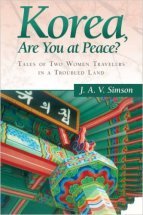Science and Spirit: “The God That Says I Am” J. A. V. Simson
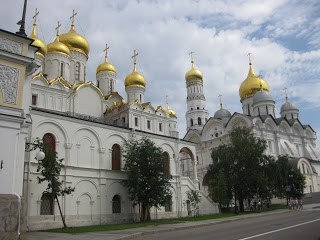

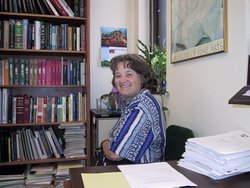
Joanne Valentine Simson is a biomedical scientist, world traveler, author, mother, and grandmother.
She has written a book about God.
“God said to Moses, ‘I AM who I AM.’ He said further, ‘Thus you shall say to the Israelites, ‘I AM has sent me to you”” (Exodus 3:14).
“He saw a bush that was burning but not consumed. . .and the flaming bush answered in a phrase (YHWH) that is virtually impossible to translate with complete accuracy, ‘I AM,‘ or ‘I-Am-That-Which-Is’ or ‘I-Am-All-Being’ or ‘I-Bring-Into-Being-All-That-Is'” (Simson, 9).
I AM: The Bread of Life (6:35); The Light of the World (8:12); The Gate for the Sheep (10:7); The Good Shepherd (10:11); The Resurrection and the Life (11:25); The Way, the Truth, and the Life (14:6); The True Vine (15:1) (The Gospel According to John).
Jesus said to them, “Very truly, I tell you, before Abraham was, I AM” (The Gospel According to John 8:58).
From J.A.V. Simson’s blog: a post about her trip to Russia
“After that, we visited the cathedrals inside Kremlin Square – an impressive aggregate of white churches with gold domes. We went into the Cathedral of the Dormition, with its large, thick, circular pillars supporting arches high above the floor, layer upon layer of frescoes covering the walls and pillars, all telling some story, now lost on most viewers. The cathedral was built in the late 15th century, and it is the church where the coronation of tsars and emperors took place. A throne of Ivan IV stood before the iconostasis, crowded with silver-bordered icons. We were not allowed to take photographs.
We did not go into any of the other churches.”
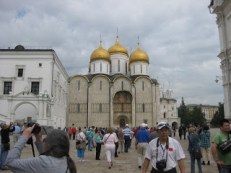

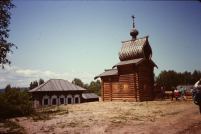
Joanne blogs at joannevalentinesimson and Solo Women at Home and Abroad.
The God that Says I AM first caught my attention because of the title. Thirty years ago I wrote, and have since taught, a course I called “The Hebrew Bible as Literature,” and central to much of that text is this business of naming. It is a powerful ritual in ancient cultures, and in some ways God’s response to Moses’ question boils down to “None of your business. I just am; get on with your job.” This is a scene in which Moses is devising one excuse after another for not getting on with the job God has assigned him–to liberate the Israelites from bondage in Egypt.
The same dynamic is evident in one of my favorite stories–Jacob Wrestling With the ‘Angel.’ Or, in some translations, ‘a man.’ In any event, clearly a Divine presence of some sort. When Jacob asks for the man’s name, the response is not unlike the one to Moses, “Why is it that you ask my name?” (Genesis 32:29). And, in fact, Jacob knows exactly who this man or angel is, for he says, after he receives his own new name, Israel, “I have seen God face to face and yet my life is preserved.”
The God of the Torah, and the God of Joanne Simson’s book, is a God of No Name and a God whose name is Everything. I AM. I am reminded of another famous tale of God’s response to the demand that, in some way, he identify himself. In the Book of Job, the demand is that God prove he is just and fair. When he finally appears, out of a whirlwind, he doesn’t even give a nod to Job’s questions. What he says, in effect, is “I AM.” Questioned too closely, he once again confronts “Where were you when I laid the foundation of the earth. . .when the morning stars sang together and all the heavenly beings shouted for joy? (Job 38:1, 7). I AM.
It is evident from the first page of the prologue that Ms. Simson knows her Bible. It is equally clear that this is a scientist, wed in a comfortable union to the scientific method of inquiry–and yet, she qualifies:
“My approach will be that of an introspective scientist, a biologist who has long been interested in the ‘numinous’ . . .”
This author, like her subject, is not going to be easy to name.
Joanne Simson explores several paths through the realities that surround us on every side. She confesses, early on, that
“. . .reading and experiences have broadened my vision bur have not settled the issue that has plagued me more or less constantly since about the age of ten: Is there such an entity as God, and if so, does It, in any manifestation, influence human existence?”
The scientist, the scholar, the theologian and student of world religions, the linguist, and the woman whose “credo” has been a “relativistic theistic agnosticism,” all bring their determination and their considerable intellect to bear on this probably unanswerable question.
Simson frequently begins with categories and questions that introduce and frame her inquiry. Then, under subheadings like “Perceptual Intensity and Spiritual Experience,” she asserts her belief that
“the internal experience I have of being, of consciousness–that part of me that say, ‘I AM’–is, I believe, at the core of the spiritual dimension of my human experience. Many have called this experience ‘the presence of the Holy Spirit’ or the ‘God-within,’ or a conscience or the sense of the ‘numinous.'”
“The kingdom of God is within you” (Luke 17:21).
As it turns out, Simson soon shrugs off any “voice” of pure scientific research and tells us more than a little about herself. In writing about God, she has become transparent and her conclusions are crystal clear and not at all provable scientific evidence of anything–let alone God.
For this author, the true spiritual experience is about connectedness, about relationship, and ultimately about love. For her, “love has been among the keenest forms of spiritual experience.” She writes about peyote and other hallucinogenic drugs in an open and inquiring way and ends that discussion with a question: Can they facilitate the dissolving of boundaries necessary for a spiritual experience? She considers that they might but far prefers Reality–where truth is likeliest to be found.
You will find, in this small gem of a book, an entire chapter on worship in which Simson considers some of the rituals–Western and non-Western–that can involve. There is a chapter in which she defines and discusses religion and its companion, theology.
Attached to the end of the book is an exhaustive Glossary intended to clarify the exact sense in which she uses words like faith and miracle, love and meaning, worship and sin.
Two short sections conclude what Simson simply calls “The Final Chapter.” The first is ‘Where Do We Go From Here?” in which she poses this question:
“And what happens to our internal reality when we die?”
I believe it is worth including here the first paragraph of the last section of The God That Says I AM–‘Where Are We Now?’
“It is possible that some natural force ‘out there’ represents what humans have tried to connect with spirituality throughout the millennia. If so, it is a Reality we can never completely understand, and one we cannot (and should not try to) bring under control. We can be content to live on Earth in such a way that our lives are of worth and value to ourselves, to others, and, insofar as possible, to the universe as a whole, by striving to be creative and not destructive. Every life changes the world around it; the universe is altered irrevocably because each of us has lived.”
Find out more about Joanne at:
https://www.facebook.com/JAVSimson
She blogs at:
Look for Korea, Are You At Peace? Tales of Two Women Travelers in a Troubled Land. amazon.com korea
The post Science and Spirit: “The God That Says I Am” J. A. V. Simson appeared first on Dean Robertson.

